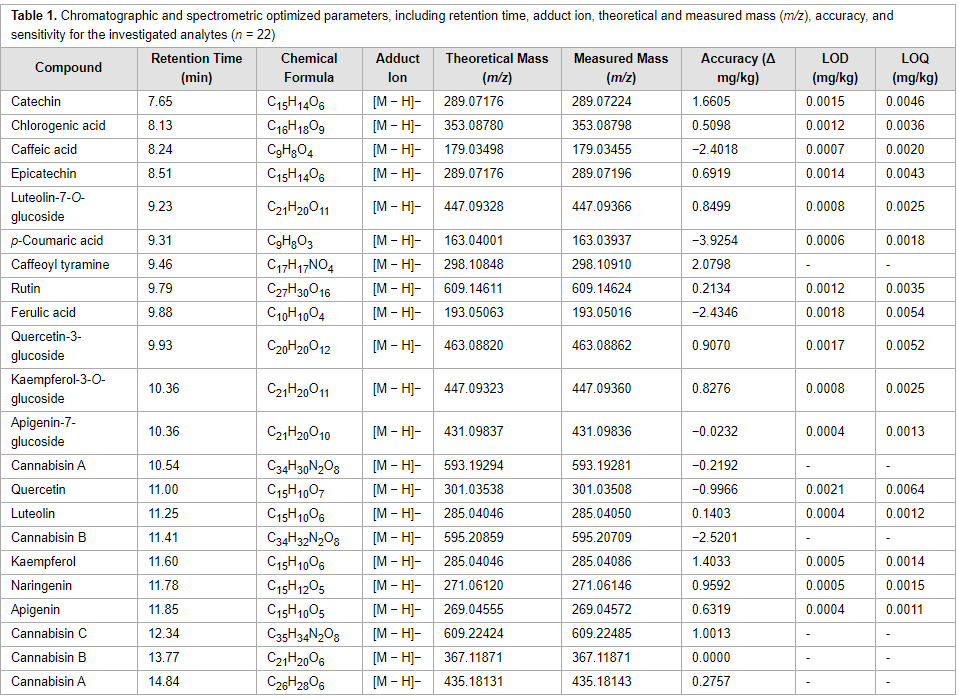Difference between revisions of "Template:Article of the month"
Shawndouglas (talk | contribs) (Updated for January) |
Shawndouglas (talk | contribs) (Updated for February) |
||
| Line 1: | Line 1: | ||
<div style="float: left; margin: 0.5em 0.9em 0.4em 0em;">[[File: | <div style="float: left; margin: 0.5em 0.9em 0.4em 0em;">[[File:IzzonAnalysisPhenolTab1Screen.png|240px]]</div> | ||
'''"[[Journal:Analysis of | '''"[[Journal:Analysis of phenolic compounds in commercial Cannabis sativa L. inflorescences using UHPLC-Q-Orbitrap HRMS|Analysis of phenolic compounds in commercial Cannabis sativa L. inflorescences using UHPLC-Q-Orbitrap HRMS]]"''' | ||
[[Hemp| | Industrial [[Hemp|hemp]] (''[[Cannabis sativa|Cannabis sativa]]'' L., family [[Cannabaceae|Cannabaceae]]) contains a vast number of relevant bioactive organic compounds, namely [[Polyphenol|polyphenols]], including [[Flavonoid|flavonoids]], phenolic acids, phenol amides, and lignanamides, which are well known for their therapeutic properties. Nowadays, many polyphenol-containing products made from herbal extracts are marketed, claiming to have health-promoting effects. In this context, industrial hemp [[Inflorescence|inflorescences]] may represent an innovative source of bioactive compounds to be used in nutraceutical formulations. The aim of this work was to provide a comprehensive analysis of the polyphenolic fraction contained in polar extracts of four different commercial cultivars—Kompolti, Tiborszallasi, Antal, and Selected Carmagnola (CS)—of hemp inflorescence ... ('''[[Journal:Analysis of phenolic compounds in commercial Cannabis sativa L. inflorescences using UHPLC-Q-Orbitrap HRMS|Full article...]]''')<br /> | ||
<br /> | <br /> | ||
''Recently featured'': | ''Recently featured'': | ||
: ▪ [[Journal:Analysis of cannabidiol, delta-9-tetrahydrocannabinol, and their acids in CBD/hemp oil products|Analysis of cannabidiol, delta-9-tetrahydrocannabinol, and their acids in CBD/hemp oil products]] | |||
: ▪ [[Journal:Screening for more than 1,000 pesticides and environmental contaminants in cannabis by GC/Q-TOF|Screening for more than 1,000 pesticides and environmental contaminants in cannabis by GC/Q-TOF]] | : ▪ [[Journal:Screening for more than 1,000 pesticides and environmental contaminants in cannabis by GC/Q-TOF|Screening for more than 1,000 pesticides and environmental contaminants in cannabis by GC/Q-TOF]] | ||
: ▪ [[Journal:Cannabis contaminants limit pharmacological use of cannabidiol|Cannabis contaminants limit pharmacological use of cannabidiol]] | : ▪ [[Journal:Cannabis contaminants limit pharmacological use of cannabidiol|Cannabis contaminants limit pharmacological use of cannabidiol]] | ||
Revision as of 20:52, 31 January 2021
Industrial hemp (Cannabis sativa L., family Cannabaceae) contains a vast number of relevant bioactive organic compounds, namely polyphenols, including flavonoids, phenolic acids, phenol amides, and lignanamides, which are well known for their therapeutic properties. Nowadays, many polyphenol-containing products made from herbal extracts are marketed, claiming to have health-promoting effects. In this context, industrial hemp inflorescences may represent an innovative source of bioactive compounds to be used in nutraceutical formulations. The aim of this work was to provide a comprehensive analysis of the polyphenolic fraction contained in polar extracts of four different commercial cultivars—Kompolti, Tiborszallasi, Antal, and Selected Carmagnola (CS)—of hemp inflorescence ... (Full article...)
Recently featured:
